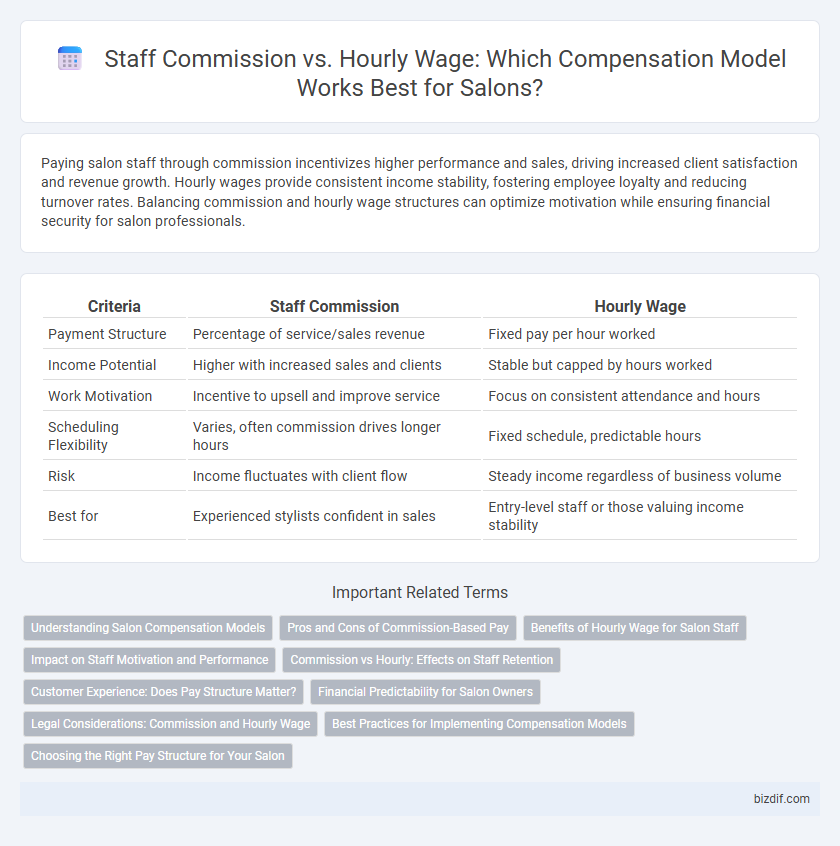Paying salon staff through commission incentivizes higher performance and sales, driving increased client satisfaction and revenue growth. Hourly wages provide consistent income stability, fostering employee loyalty and reducing turnover rates. Balancing commission and hourly wage structures can optimize motivation while ensuring financial security for salon professionals.
Table of Comparison
| Criteria | Staff Commission | Hourly Wage |
|---|---|---|
| Payment Structure | Percentage of service/sales revenue | Fixed pay per hour worked |
| Income Potential | Higher with increased sales and clients | Stable but capped by hours worked |
| Work Motivation | Incentive to upsell and improve service | Focus on consistent attendance and hours |
| Scheduling Flexibility | Varies, often commission drives longer hours | Fixed schedule, predictable hours |
| Risk | Income fluctuates with client flow | Steady income regardless of business volume |
| Best for | Experienced stylists confident in sales | Entry-level staff or those valuing income stability |
Understanding Salon Compensation Models
Salon compensation models vary primarily between staff commission and hourly wage structures, each offering distinct financial incentives and stability. Commission-based pay motivates stylists by directly linking earnings to services and product sales, often leading to higher income potential during busy periods. In contrast, hourly wages provide consistent, predictable income, supporting employees who prefer financial stability regardless of fluctuating client volumes.
Pros and Cons of Commission-Based Pay
Commission-based pay motivates salon staff by directly linking earnings to performance, encouraging higher service sales and product recommendations, which can boost overall revenue. However, reliance on commissions may cause income instability and increase stress for employees during slower periods, potentially affecting customer service quality. Some staff may prioritize high-commission services over client needs, leading to ethical concerns and client dissatisfaction.
Benefits of Hourly Wage for Salon Staff
Hourly wage offers salon staff predictable income, fostering financial stability and reducing stress related to fluctuating commissions. This payment structure encourages focus on quality customer service rather than rushing clients to maximize earnings, which can enhance client satisfaction and retention. Hourly wages often come with benefits such as paid time off and consistent working hours, contributing to improved work-life balance and employee well-being.
Impact on Staff Motivation and Performance
Commission-based pay in salons often enhances staff motivation by directly linking earnings to service quality and sales, encouraging higher performance and client satisfaction. Hourly wages provide financial stability, which can reduce stress but may lead to less incentive for staff to exceed basic expectations or upsell services. Balancing commission with a guaranteed hourly rate can optimize motivation, blending security with performance-driven rewards.
Commission vs Hourly: Effects on Staff Retention
Commission-based pay in salons often boosts stylist motivation and performance, directly linking earnings to services rendered and product sales, which can enhance staff retention by rewarding productivity. Hourly wage structures provide income stability and predictability, appealing to staff seeking financial security but sometimes lacking the incentive for higher sales efforts. Salons balancing these approaches may achieve optimal staff retention by offering a base hourly wage combined with commission opportunities, aligning financial rewards with both stability and performance.
Customer Experience: Does Pay Structure Matter?
Staff commission in salons often incentivizes employees to provide personalized services and upsell treatments, enhancing customer satisfaction through tailored experiences. Hourly wages create a stable income, encouraging staff to focus on quality without the pressure of sales, which can lead to more relaxed, attentive customer interactions. Balancing pay structures can optimize motivation and service quality, directly impacting the overall client experience.
Financial Predictability for Salon Owners
Paying staff through commission offers salon owners financial flexibility by aligning wages with actual sales performance, reducing fixed labor costs during slower periods. Hourly wages provide predictable payroll expenses, enabling more accurate budgeting and cash flow management regardless of client volume. Salon owners must weigh the balance between incentivizing productivity and maintaining stable financial forecasting when choosing between commission and hourly wage models.
Legal Considerations: Commission and Hourly Wage
Salon staff compensation structures must comply with labor laws regarding commission and hourly wage payments to avoid legal disputes. Employers need to ensure that commission-based pay meets minimum wage requirements when converted to hourly earnings and maintain accurate records of hours worked and sales made. Failure to adhere to regulations such as overtime rules and wage transparency can result in penalties and back pay claims.
Best Practices for Implementing Compensation Models
Choosing between staff commission and hourly wage models in salons hinges on aligning incentives with performance and client satisfaction. Implementing a commission structure typically motivates stylists to increase sales and retain clients, while hourly wages ensure consistent income and can reduce employee turnover. Best practices involve clear communication of compensation terms, regular performance reviews, and combining base pay with commission to balance financial stability and reward excellence.
Choosing the Right Pay Structure for Your Salon
Choosing the right pay structure for your salon hinges on balancing staff motivation and operational costs. Commission-based pay incentivizes stylists by rewarding higher sales and client retention, promoting a performance-driven culture. Hourly wages offer predictable expenses and financial stability, appealing to employees who value consistent income over variable earnings.
Staff Commission vs Hourly Wage Infographic

 bizdif.com
bizdif.com